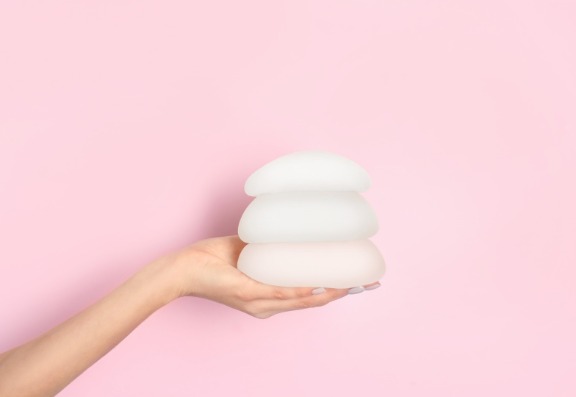When it comes to a breast augmentation or a boob job, one of the important parts of the process is how do you get the breast implant precisely into the chest via a relatively small incision without causing additional trauma or risking infection; this can be done one of two ways, by the surgeon using his finger to literally push and poke the implant in (a digital method as it uses a digit or finger), or by using an aid which assists the surgeon in pushing the implant into the hole created without him having to touch it.
Although very rare, an infection arising during a breast augmentation operation caused by a biofilm formation (i.e. a thin layer of bacteria adhering itself to the surface of the silicone implant) can lead to serious problems such as capsular contracture, whereby the body’s immune response creates a hard, tightening capsule or scar tissue around an object, in this case, a breast implant, in an effort to expel the infected ‘foreign body’ which it sees as a threat; this then leads to the need for revision surgery to remove the implant and affected tissue and treatment for the infection. Such complications, although not common nowadays are therefore best avoided due to the potential pain, discomfort and trauma they can cause for the patient.
A recent paper published in the Aesthetic Surgery Journal* examined a digital versus a Keller funnel or ‘no touch’ technique of insertion and placement of smooth silicone gel breast implants during surgery, and whether the funnel technique, up to that point unproven in reducing bacterial contamination could live up to its claims of being a better technique for reducing potential contamination which could lead to post-operative infection.

The Keller Funnel is a medical device which is essentially a tear-resistant nylon sleeve lined with a hydrophilic or water-attracting inner coating which when primed with sterile saline becomes lubricated so assisting the flow of an implant through itself. Simply put, the device is much like a piping bag used in cake making but instead of pushing out royal icing, you are pushing out an implant via a pre-sized hole at the end which is placed directly into the incision in the breast.
In the published study the two different insertion techniques of smooth, round, moderate silicone breast implants were performed using two fresh cadaver models (i.e. recently deceased people who gave their bodies to medical science).
In order to work out the potential amount of skin contamination caused by the two different techniques, a fluorescent paste was painted on the chest of the cadaver to simulate bacteria upon the outer skin. The implants were then placed into the body using one or another technique.
After implantation, the implants were soaked in 250ml of sterile water, and the fluorescence emission of the resulting solution was measured with an ultraviolet-visible spectrophotometer, thus enabling them to see how much of the florescent paste had got onto the implant during the insertion process.
Additionally, to work out the potential contamination that could have occurred the breast tissue of the cadaver was swabbed with methicillin-sensitive staphylococcus aureus, commonly known as the superbug MSSA and the implant surfaces were cultured following implantation to review bacteria growth.

The results of the study showed that the funnel method showed a 27-fold decrease in skin contact for the insertion of all smooth gel implants compared to the digital technique. However, the amount of skin contact and potential contamination increased incrementally with an increase in the volume of the breast implant, whether the digital or funnel techniques were used. Bacterial contamination was shown to be two times more likely with the standard digital insertion technique than with the funnel. The study authors, therefore, concluded that the use of the Keller funnel appears to significantly reduce the amount of skin contact and thus potential bacterial contamination of the implant site.
Although this particular device is not commonly used in the UK, it is reassuring to know that surgeons around the world are continuing to develop techniques and methods of surgical practice that produce not only good, aesthetic results for patients but which also aim to avoid the risks commonly associated with all types of surgery.
If you’re a cosmetic surgeon, we’d love to hear your opinions and first-hand experience of techniques for implant insertion during breast augmentation surgery.
* Aesthetic Surgery Journal (February 2012 vol. 32 no. 2 194-199)
Contamination in Smooth Gel Breast Implant Placement: Testing a Funnel Versus Digital Insertion Technique in a Cadaver Model
Hunter R. Moyer, Bahair Ghazi, Neil Saunders, Albert Losken
Division of Plastic and Reconstructive Surgery, Emory University, Atlanta, Georgia
If you want to read more, the experts at Consulting Room really know what they're talking about and have put together breast augmentation, boob job and scarring FAQs just for you.
If you have more questions, you can use the breast augmentation, boob job and scarring questions feature to talk to our panel of trained medical experts.
If you're keen to get started with any of these treatments right away then you're in luck - those clever folks also have a list of trusted, accredited breast augmentation, boob job and scarring clinics in your area.
A recent investigation by 5 News has raised alarm over UK clinics using illegal human-derived exosomes in so-called “next-gen” facials - the latest TikTok-fuelled trend promising younger, smoother skin.
You’ve definitely heard the buzz about Polynucleotides… but what are they really?
Hey, wait!
Before you go.....
Let's stay in touch, pop your details here and we'll send our editor's hand-picked updates on your fave subjects.